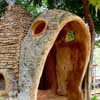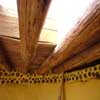Sustainable architecture design opinion, Climate Change building progress, Sustainability meaning
Sustainable Architecture Design
Architecture Sustainability Discussion by Trevor Tucker: Built Environment Strategy
18 Aug 2009
Sustainability in the Built Environment – Opening Lines
Three months ago, following a meeting with pioneer Bill Teron, I started on my own journey – this one into sustainable architecture. As the founder of Kanata, an early “garden city” just outside of Ottawa, the recommendation was Teron’s, in response to my own hopes of one day becoming an architect. “There are two trains,” he says. “One I think you can catch; the other…not so likely.” Sustainable architecture was the catchable train. With technologies emerging by the day, and few true experts in the field, developing a niche in green building practices seemed possible.
“But I just want to do architecture,” I was thinking as I left Teron’s office. “I’d rather steer clear of that lot of modern hippies and ecologues.”
Sustainable Architecture Design Opinion
I was wrong. The field of sustainable architecture is just as varied as any. For every James Wines there is a Ken Yeang; for every eco-messiah there is a practical person with truly useful ideas.
Over the months of nosing around this new terrain, some key themes have regularly sprung up. Read Ken Yeang’s “Eco Design” and you will see buildings like you’ve never seen before. Yeang, convinced of the practical needs of building high-rises, working mostly in the pacific rim, has taken cold concrete blocks and turned them into porous, organic, ecological communities that are as beautiful to the eye as they are practical in their response to environmental concerns. These are not glass cubes with solar panels on top. When one can incorporate sky gardens, wind scoops, vegetation-laden ramps from ground to top, individual heating and cooling systems, and a variety of public spaces, urban life does not seem so cold and alien. I never thought I’d be drawn to designing urban high-rises, but butterflies on rooftops? That’s an inviting image.
Through reading the life and work of Frederick Law Olmstead, landscape architecture-an essential cross-disciplinary partner of sustainable architecture-has also piqued my interest. Not surprisingly, the park movement and the value ascribed to landscape architecture are experiencing a resurgence. Again, the concept of greening architecture offers a kind of new life to cold, modern, buildings. If the beauty of ornamentation-with its gargoyles and rosettes-is a thing of the past, perhaps today we can dress up our overly casual, ultra-utilitarian buildings with a flourish of nature, albeit one that fits. Maybe we can even go further and reconcile ourselves to the notion that “Ornamentation is the end [the aim] of architecture,” as Ruskin claimed, by designing architecture toward the ecological environment it will support, rendering it hypercontextual.
All that being said, I’ve ended up with more questions than answers. The philosophical implications of the green shift are many, and James Wines, and some of the leading websites on sustainability, like WorldWatch and Worldchanging, have provided ample grist for the mill. What, for example, are the implications of designs that trumpet a return to living in the earth rather than on it? Apparently, many architects think that’s where we belong…back in the cave. Humanity is a scourge on the earth, civilization has failed its beneficent landlord, and we should either start over or check out. Well, my Sunday School teachers and every potato-salad-making church lady in partial charge of my early tutelage have grilled me enough to shun that pagan foray. We are flesh and spirit, and architecture must speak to both sides. The Wild Man and the signature of the divine are at work in each of us, and to ignore either is risky business. How, then, can sustainable architecture speak to the whole person? It seems to me that any sustainable practice has to address this question.
Of course, this leads to the more aesthetic question of how to incorporate technological design components into an entire architectural concept. We’ve all seen them: beautiful buildings, designed as a unity, but with solar panels plunked on top like a gaudy hat. Surely, there must be a way to see this stuff as art and incorporate it as such. Beyond dollars and cents, what is the symbolic value of eco-technologies? What do they signify to the subconscious? Can precedents be found in traditional architecture? Clearly, gargoyle’s, Roman zoning, courtyards, and convection towers spoke to both form and function.
It’s a long list of questions, and one that has to do as much with our view of human nature as it does with the physical needs of a resource-conscious era. Maybe it’s as simple as people wanting to live and work in beautiful places. What will erupt out of this potent mergence of old and new, complex technology and at-your-doorstep nature? Man-made and nature-made?
I just keep thinking of butterflies on rooftops.
Trevor Tucker
Editor and sessional professor of English literature at the University of Ottawa
Trevor Tucker
Comments on the Sustainable Architecture Design article by Trevor Tucker are welcome.
Sustainable Architectural Designs
Global Built Environment Strategy articles welcome, with an architectural focus
Sustainable Buildings – Building Issues : Article by Adrian Welch
Sustainable Design : article by Trevor Tucker. 15 Sep 2009
Example of sustainable architecture design:
Soneva Kiri Resort, Koh Kood, Gulf of Thailand
24H > architecture

photo from architects
Six Senses’ Soneva Kiri Resort
Energy Island : Maritime Energy Generation

picture from architect
Sustainable Architecture : main page
Sustainable Timber Building

photo © Adrian Welch
Sustainable Home Architecture : Lotte Glob House
Comments for the Sustainable Architecture Design – Green Buildings page welcome

